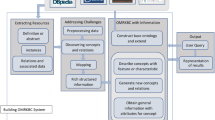Abstract
In this paper, a new approach of automatic building for domain ontology based on machine learning algorithm is proposed, and by which the large-scale e-Gov ontology is built automatically. The advent of the knowledge graph era puts forward higher requirements for semantic search and analysis. Since traditional manual ontology construction requires the participation of domain experts in large-scale ontology construction, which will take time and considerable resources, and the ontology scale is also limited. The approach proposed in this paper not only makes up for the shortage of thesaurus description of the semantic relation between terms, but also takes advantage of the massive online encyclopedia knowledge and typical similarity algorithm in machine learning to fill the domain ontology automatically, so that the advantages of the two different knowledge sources are fully utilized and the system as a whole is gained. Ultimately, this may provide the foundation and support for the construction of knowledge graph and the semantic-oriented applications.

Similar content being viewed by others
Explore related subjects
Discover the latest articles and news from researchers in related subjects, suggested using machine learning.References
Berners-Lee T, Hendler J et al (2001) The semantic web. Scientific American, New York
Seung Jin L, Yiu Kai N (1999) An automated approach for retrieving hierarchical data from HTML tables. In: Proceedings of the 8th international conference on information and knowledge management. ACM, New York, N.Y., USA, pp 466–474
Yoshida M, Torisawa K, Tsujii J (2001) Extracting ontologies from world wide web via HTML tables. In; Proceedings of the Pacific association for computational linguistics. Morgan Kaufman, San Francisco, Cal., USA, pp 332–341
Tijerino YA, David WE, Deryle WL et al (2005) Towards ontology generation from tables. World Wide Web 8(3):261–285
Embley D, Cui T, Liddle S (2005) Automating the extraction of data from HTML tables with unknown structure. Data Knowl Eng 54(1):3–28
Aleksander P (2005) Automatic ontology generation from Web tabular structures. University of Maribor, Maribor
Hurst M (1999) Layout and language: beyond simple text for information interaction—modeling the table. In: Proceedings of the 2nd international conference on multimodal interfaces. Hong Kong Baptist University, Hong Kong, China, pp 27–30
Tanaka M, Ishida T (2006) Ontology extraction from tables on the web. In: Proceedings of 2006 international symposium on applications and the internet. IEEE Computer Society, Los Alamitos, CA, USA, pp 284–290
Wu F, Weld DS (2008) Automatically refining the wikipedia infobox ontology. In: Proceedings of the 17th international conference on world wide web. ACM, New York, pp 635–644
Wu F, Weld DS (2007) Autonomously semantifying Wikipedia. In: Proceedings of the sixteenth ACM conference on information and knowledge management. ACM, New York
Suchanek FM, Kasneci G, Weikum G (2008) YAGO: a large ontology from Wikipedia and WordNet. Web Semant Sci Serv Agents World Wide Web 6(3):203–217
Wang Z, Wang Z, Li J et al (2012) Knowledge extraction from chinese wiki encyclopedias. J Zhejiang Univ Sci C 13(4):268–280
Chen Y, Chen L, Xu K (2012) Learning Chinese entity attributes from online encyclopedia. APWeb, 179–186
Lauser B et al (2006) From AGROVOC to the agricultural ontology service/concept server. An OWL model for creating ontologies in the agricultural domain. In Dublin core conference proceedings. Dublin Core DCMI
Guojian X (2008) The study and implementation of the conversion system from Chinese agricultural thesaurus to agricultural ontology. Chin Acad Agric Sci 6:101 (in Chinese)
Woods JW, Sneiderman CA, Hameed K, Ackerman MJ, Hatton C (2006) Using UMLS metathesaurus concepts to describe medical images: dermatology vocabulary. Comput Biol Med 36:89–100
Stark MM, Riesenfeld RF (1998) Wordnet: an electronic lexical database. In: Proceedings of 11th Eurographics workshop on rendering. MIT Press, Cambridge
Dong ZD, Qiang D, Hao CL (2007) Theoretical findings of HowNet. J Chin Inf Process 21(4):3–9 (in Chinese)
Tambouris E, Gorilas S, Kavadias G, Apostolou D, Abecker A, Stojanovic L, Mentzas G (2004) Ontology-enabled e-gov service configuration: an overview of the OntoGov project. In: Wimmer M (ed) Proceedings of knowledge management in electronic government—KMGov 2004—5th IFIP international working conference, pp 122–127. Springer LNAI 3035: Krems, Austria, May 17–19, 2004
Chao-chen C, Jian-hua Y, Shun-hong S (2005) Government ontology and thesaurus construction: a Taiwanese experience. ICADL 2005, LNCS, pp 263–27
Xin-li Z (2005) Chinese general e-government thesaurus (category table). Scientific and Technical Documentation Press (in Chinese)
Xin-li Z (2005) Chinese general e-government thesaurus (alphabetical table). Scientific and Technical Documentation Press (in Chinese)
Wang T, Song JC, Di RH et al (2013) A thesaurus and online encyclopedia merging method for large scale domain-ontology automatic construction. In: Wang M (ed) KSEM 2013. LNCS (LNAI), vol 8041. Springer, Heidelberg, pp 132–146
Wang T, Xu T, Tang Z et al (2017) TongSACOM: a TongYiCiCiLin and sequence alignment-based ontology mapping model for Chinese linked open data. IEICE Trans Inf Syst 100(6):1251–1261
Acknowledgements
This work was supported by the Scientific Research Project of Beijing Municipal Education Commission (General Social Science Project) and the Youth Excellent Teachers Grant of Capital University of Economics and Business (No. 23491854840429).
Author information
Authors and Affiliations
Corresponding author
Ethics declarations
Conflict of interest
The authors declare that they have no conflict of interest.
Rights and permissions
About this article
Cite this article
Wang, T., Gu, H., Wu, Z. et al. Multi-source knowledge integration based on machine learning algorithms for domain ontology. Neural Comput & Applic 32, 235–245 (2020). https://doi.org/10.1007/s00521-018-3806-5
Received:
Accepted:
Published:
Issue Date:
DOI: https://doi.org/10.1007/s00521-018-3806-5




